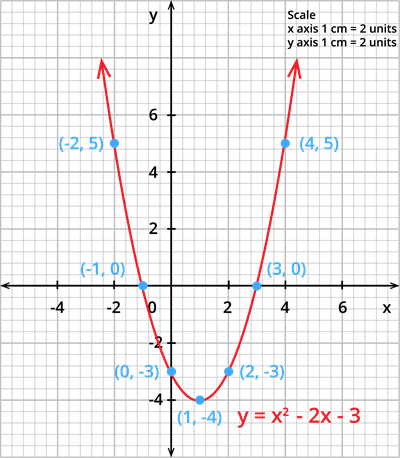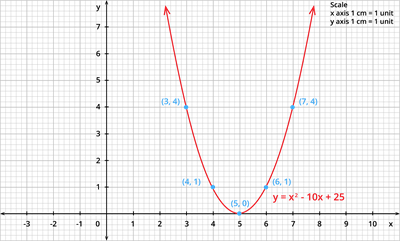UPSKILL MATH PLUS
Learn Mathematics through our AI based learning portal with the support of our Academic Experts!
Learn moreLet us discuss how to determine the nature of the solutions for the given quadratic equations.
Example:
1. Find the nature of the solution of the equation \(y = x^2 - 2x - 3\).
Solution:
Step 1: Draw the graph of the equation \(y = x^2 - 2x - 3\).
The table of values for the equation \(y = x^2 - 2x - 3\) is:
| \(x\) | \(-2\) | \(-1\) | \(0\) | \(1\) | \(2\) | \(3\) | \(4\) |
| \(x^2\) | \(4\) | \(1\) | \(0\) | \(1\) | \(4\) | \(9\) | \(16\) |
| \(2x\) | \(-4\) | \(-2\) | \(0\) | \(2\) | \(4\) | \(6\) | \(8\) |
| \(3\) | \(3\) | \(3\) | \(3\) | \(3\) | \(3\) | \(3\) | \(3\) |
| \(y\) | \(5\) | \(0\) | \(-3\) | \(-4\) | \(-3\) | \(0\) | \(5\) |
Step 2: Plot the points in the graph using a suitable scale.

Step 3: Join the points by a smooth curve.
Step 4: In the graph, observe that the curve intersects the \(X\) - axis at \(2\) points \((-1,0)\) and \((3,0)\). Therefore, the roots of the equation are \(-1\) and \(3\).
Since there are two points of intersection with the \(X\) - axis, the given equation has real and unequal roots.
2. Find the nature of the solutions of the equation \(y = x^2 - 10x + 25\).
Solution:
Step 1: Draw the graph of the equation \(y = x^2 - 10x + 25\).
The table of values for the equation \(y = x^2 - 10x + 25\) is given by:
| \(x\) | \(3\) | \(4\) | \(5\) | \(6\) | \(7\) |
| \(x^2\) | \(9\) | \(16\) | \(25\) | \(36\) | \(49\) |
| \(10x\) | \(30\) | \(40\) | \(50\) | \(60\) | \(70\) |
| \(25\) | \(25\) | \(25\) | \(25\) | \(25\) | \(25\) |
| \(y\) | \(4\) | \(1\) | \(0\) | \(1\) | \(4\) |
Step 2: Plot the points in the graph.

Step 3: Join the points by a smooth curve.
Step 4: Here, the curve meets the \(X\) - axis at only one point. Therefore, the point of intersection of the parabola with \(X\) - axis for the given equation is \((5,0)\).
Since the point of intersection is only one point with \(X\) - axis, the given quadratic equation has real and equal roots.